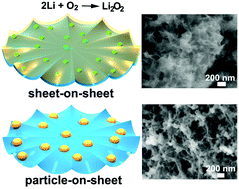Nanostructured porous RuO2/MnO2 as a highly efficient catalyst for high-rate Li–O2 batteries†
Abstract
Despite the recent advancements in Li–O2 (or Li–air) batteries, great challenges still remain to realize high-rate, long-term cycling. In this work, a binder-free, nanostructured RuO2/MnO2 catalytic cathode was designed to realize the operation of Li–O2 batteries at high rates. At a current density as high as 3200 mA g−1 (or ∼1.3 mA cm−2), the RuO2/MnO2 catalyzed Li–O2 batteries with LiI can sustain stable cycling of 170 and 800 times at limited capacities of 1000 and 500 mA h g−1, respectively, with low charge cutoff potentials of ∼4.0 and <3.8 V, respectively. The underlying mechanism of the high catalytic performance of MnO2/RuO2 was also clarified in this work. It was found that with the catalytic effect of RuO2, Li2O2 can crystallize into a thin-sheet form and realize a conformal growth on sheet-like δ-MnO2 at a current density up to 3200 mA g−1, constructing a sheet-on-sheet structure. This crystallization behavior of Li2O2 not only defers the electrode passivation upon discharge but also renders easy decomposition of Li2O2 upon charge, leading to low polarizations and reduced side reactions. This work provides a unique design of catalytic cathodes capable of controlling Li2O2 growth and sheds light on the design of high-rate, long-life Li–O2 batteries with potential applications in electric vehicles.


 Please wait while we load your content...
Please wait while we load your content...